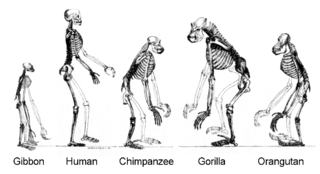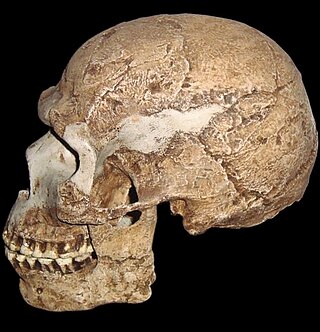Related Research Articles

Human evolution is the evolutionary process within the history of primates that led to the emergence of Homo sapiens as a distinct species of the hominid family, which includes all the great apes. This process involved the gradual development of traits such as human bipedalism, dexterity and complex language, as well as interbreeding with other hominins, indicating that human evolution was not linear but weblike. The study of human evolution involves several scientific disciplines, including physical and evolutionary anthropology, paleontology, and genetics.

Svante Pääbo is a Swedish geneticist and Nobel Laureate who specialises in the field of evolutionary genetics. As one of the founders of paleogenetics, he has worked extensively on the Neanderthal genome. In 1997, he became founding director of the Department of Genetics at the Max Planck Institute for Evolutionary Anthropology in Leipzig, Germany. Since 1999, he has been an honorary professor at Leipzig University; he currently teaches molecular evolutionary biology at the university. He is also an adjunct professor at Okinawa Institute of Science and Technology, Japan.

Early modern human (EMH) or anatomically modern human (AMH) are terms used to distinguish Homo sapiens that are anatomically consistent with the range of phenotypes seen in contemporary humans, from extinct archaic human species. This distinction is useful especially for times and regions where anatomically modern and archaic humans co-existed, for example, in Paleolithic Europe. Among the oldest known remains of Homo sapiens are those found at the Omo-Kibish I archaeological site in south-western Ethiopia, dating to about 233,000 to 196,000 years ago, the Florisbad site in South Africa, dating to about 259,000 years ago, and the Jebel Irhoud site in Morocco, dated about 315,000 years ago.

Early human migrations are the earliest migrations and expansions of archaic and modern humans across continents. They are believed to have begun approximately 2 million years ago with the early expansions out of Africa by Homo erectus. This initial migration was followed by other archaic humans including H. heidelbergensis, which lived around 500,000 years ago and was the likely ancestor of Denisovans and Neanderthals as well as modern humans. Early hominids had likely crossed land bridges that have now sunk.
The Sidrón Cave is a non-carboniferous limestone karst cave system located in the Piloña municipality of Asturias, northwestern Spain, where Paleolithic rock art and the fossils of more than a dozen Neanderthals were found. Declared a "Partial Natural Reserve" in 1995, the site also serves as a retreat for five species of bats and is the place of discovery of two species of Coleoptera (beetles).
Howiesons Poort is a technological and cultural period characterized by material evidence with shared design features found in South Africa, Lesotho, and Namibia. It was named after the Howieson's Poort Shelter archaeological site near Grahamstown in South Africa, where the first assemblage of these tools was discovered. Howiesons Poort is believed, based on chronological comparisons between many sites, to have started around 64.8 thousand years ago and ended around 59.5 thousand years ago. It is considered to be a technocomplex, or a cultural period in archaeology classified by distinct and specific technological materials. Howiesons Poort is notable for its relatively complex tools, technological innovations, and cultural objects evidencing symbolic expression. One site in particular, Sibudu Cave, provides one of the key reference sequences for Howiesons Poort. Howiesons Poort assemblages are primarily found at sites south of the Limpopo River.

Vindija Cave is an archaeological site associated with Neanderthals and modern humans, located in the municipality of Donja Voća, northern Croatia. Remains of three Neanderthals were selected as the primary sources for the first draft sequence of the Neanderthal genome project in 2010. Additional research was done on the samples and published in 2017.

The Denisovans or Denisova hominins(di-NEE-sə-və) are an extinct species or subspecies of archaic human that ranged across Asia during the Lower and Middle Paleolithic. Denisovans are known from few physical remains; consequently, most of what is known about them comes from DNA evidence. No formal species name has been established pending more complete fossil material.

Denisova Cave is a cave in the Bashelaksky Range of the Altai mountains, Siberian Federal District, Russia. The cave has provided items of great paleoarchaeological and paleontological interest. Bone fragments of the Denisova hominin originate from the cave, including artifacts dated to around 40,000 BP. Remains of a 32,000-year-old prehistoric species of horse has also been found in the cave.

Neanderthals, also written as Neandertals, are an extinct species or subspecies of archaic humans who lived in Eurasia until about 40,000 years ago. The reasons for Neanderthal extinction are disputed. Theories for their extinction include demographic factors such as small population size and inbreeding, competitive replacement, interbreeding and assimilation with modern humans, climate change, disease, or a combination of these factors.

Almost everything about Neanderthal behaviour remains controversial. From their physiology, Neanderthals are presumed to have been omnivores, but animal protein formed the majority of their dietary protein, showing them to have been carnivorous apex predators and not scavengers. Although very little is known of their social organization, it appears patrilines would make up the nucleus of the tribe, and women would seek out partners in neighbouring tribes once reaching adolescence, presumably to avoid inbreeding. The men would pass knowledge and customs down from fathers to sons. An analysis based on finger-length ratios suggests that Neanderthals were more sexually competitive and promiscuous than modern-day humans.

There is evidence for interbreeding between archaic and modern humans during the Middle Paleolithic and early Upper Paleolithic. The interbreeding happened in several independent events that included Neanderthals and Denisovans, as well as several unidentified hominins.

Denny is a ~90,000 year old fossil specimen belonging to a ~13-year-old Neanderthal-Denisovan hybrid girl. To date, she is the only first-generation hybrid hominin ever discovered. Denny’s remains consist of a single fossilized fragment of a long bone discovered among over 2,000 visually unidentifiable fragments excavated at the Denisova Cave in the Altai Mountains, Russia in 2012.

Christopher Stuart Henshilwood is a South African archaeologist. He has been Professor of African Archaeology at the University of Bergen since 2007 and, since 2008, Professor at the Chair of "The Origins of Modern Human Behaviour" at the University of the Witwatersrand. Henshilwood became internationally known due to his excavations in the Blombos Cave, where - according to his study published in 2002 - the oldest known works of humanity had been discovered. Henshilwood and his work have been featured on National Geographic and CNN Inside Africa.
Viviane Slon is a paleogeneticist at the Max Planck Institute for Evolutionary Anthropology. She identified that a teenage girl born 90,000 years ago had both Neanderthal and Denisovan parents. She was selected as one of Nature's 10 in 2018.
Zhang Dongju is a Chinese archeologist and an associate professor at the College of Earth and Environmental Sciences of Lanzhou University. Zhang's research determined that the Xiahe mandible found in the Baishiya Karst Cave on the Tibetan Plateau shared DNA with fossilized remains found in the Denisova Cave in Siberia. This moved to 120,000 years earlier the dates of earliest proven hominin activities in the Tibetan Plateau, and revealed for the first time that the Denisovan hominins had spread throughout Asia rather than being located only near the Denisova Cave. Zhang's work is considered likely to prompt reconsideration of other fossil remains using ancient protein analysis. Discover, Science News, and Nova all named the discovery to their lists of top science stories of 2019.
Katerina Douka is an archaeological scientist whose work focuses on the spatio-temporal pattern of human dispersals and extinctions across Eurasia, including Neanderthals, Denisovans and modern Homo sapiens.

The Nesher RamlaHomo group are an extinct population of archaic humans who lived during the Middle Pleistocene in what is now modern-day Israel. In 2010, evidence of a tool industry had been discovered during a year of archaeological excavations at the Nesher Ramla site. In 2021, the first Nesher Ramla Homo individual was identified from remains discovered during further excavations.
References
- 1 2 "Professor Zenobia Jacobs - Scholar Profile - University of Wollongong". scholars.uow.edu.au. Retrieved 13 March 2021.
- ↑ "Awards - International Union for Quaternary Research". INQUA. Retrieved 12 March 2021.
- ↑ "Unlocking the history of human evolution, one grain of sand at a time". Times Higher Education (THE). 30 April 2019. Retrieved 12 March 2021.
- ↑ Jacobs, Zenobia; Roberts, Richard G. (2007). "Advances in optically stimulated luminescence dating of individual grains of quartz from archeological deposits". Evolutionary Anthropology: Issues, News, and Reviews. 16 (6): 210–223. doi:10.1002/evan.20150. ISSN 1520-6505. S2CID 84231863.
- ↑ "New Studies Reveal Deep History of Denisovans and Neanderthals in Southern Siberia". www.shh.mpg.de. Retrieved 12 March 2021.
- ↑ Gibbons, Ann (29 October 2020). "DNA tracks mysterious Denisovans to Chinese cave, just before modern humans arrived nearby". Science. AAAS. Retrieved 12 March 2021.
- ↑ Jacobs, Zenobia; Roberts, Richard G.; Galbraith, Rex F.; Deacon, Hilary J.; Grün, Rainer; Mackay, Alex; Mitchell, Peter; Vogelsang, Ralf; Wadley, Lyn (31 October 2008). "Ages for the Middle Stone Age of Southern Africa: Implications for Human Behavior and Dispersal". Science. 322 (5902): 733–735. Bibcode:2008Sci...322..733J. doi:10.1126/science.1162219. hdl: 1885/32902 . ISSN 0036-8075. PMID 18974351. S2CID 206514762.
- ↑ Roberts, David L.; Karkanas, Panagiotis; Jacobs, Zenobia; Marean, Curtis W.; Roberts, Richard G. (2012). "Melting ice sheets 400,000 yr ago raised sea level by 13m: Past analogue for future trends". Earth and Planetary Science Letters. 357–358: 226–237. Bibcode:2012E&PSL.357..226R. doi:10.1016/j.epsl.2012.09.006.
- ↑ Clarkson, Chris; Jacobs, Zenobia; Marwick, Ben; Fullagar, Richard; Wallis, Lynley; Smith, Mike; Roberts, Richard G.; Hayes, Elspeth; Lowe, Kelsey; Carah, Xavier; Florin, S. Anna (2017). "Human occupation of northern Australia by 65,000 years ago". Nature. 547 (7663): 306–310. Bibcode:2017Natur.547..306C. doi:10.1038/nature22968. hdl: 2440/107043 . ISSN 1476-4687. PMID 28726833. S2CID 205257212.
- ↑ Dewar, Robert E.; Radimilahy, Chantal; Wright, Henry T.; Jacobs, Zenobia; Kelly, Gwendolyn O.; Berna, Francesco (30 July 2013). "Stone tools and foraging in northern Madagascar challenge Holocene extinction models". Proceedings of the National Academy of Sciences. 110 (31): 12583–12588. Bibcode:2013PNAS..11012583D. doi: 10.1073/pnas.1306100110 . ISSN 0027-8424. PMC 3732966 . PMID 23858456.